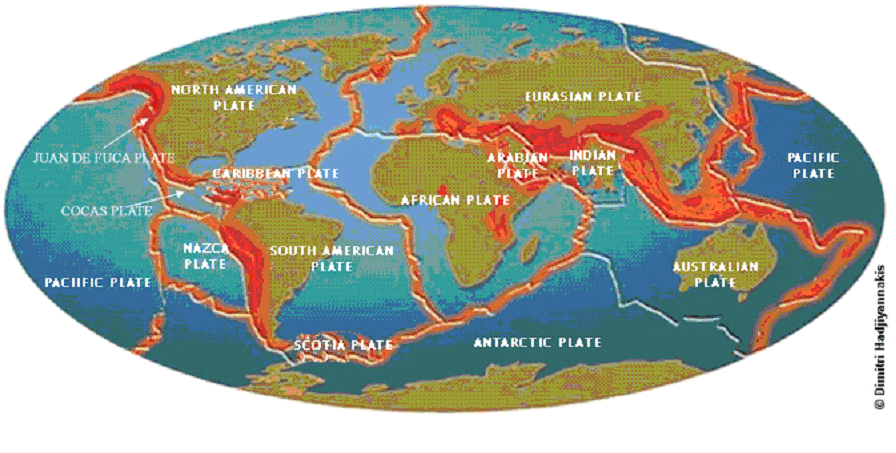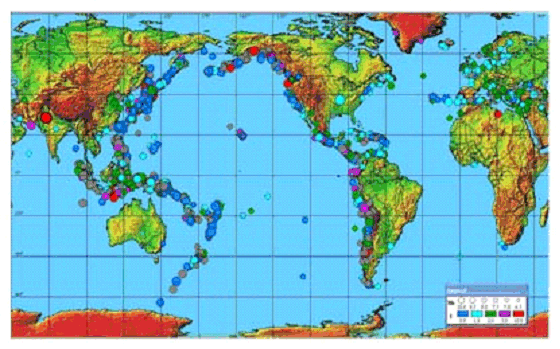SENAT
Report n° 117 (2007-2008) by M. Roland COURTEAU, Senator (for the parliament office for the evaluation of scientific and technological choices) - Appendix to the minutes of the 7 December 2007 session
Disponible au format Acrobat (21 Moctets)
2. A natural phenomenon of unequal geographical distribution
The most dangerous zones are those with the greatest seismic activity: in other words, those zones where the tectonic plates converge, either by subduction (with one plate sliding beneath another) or collision.
Tectonic plate map

Source: CEA
Since the beginning of the 20th century, 911 tsunamis have been reported in the world (for an average of 9 per year). 98 tsunamis were characterized by waves of between 1 and 5 metres (an average of 1 per year). 6 teletsunamis occurred with waves of over 5 metres and a distance travelled of over 5,000 km.
a) A greater frequency in the Pacific
According to the information gathered by your rapporteur during his hearings, of the 2,180 tsunamis recorded all over the world between the years - 1650 (supposed date of the Thera Volcano eruption on Santorini) and 2005, 59% occurred in the Pacific, 25% in the Mediterranean, 12% in the Atlantic and 4% in the Indian Ocean.
However, the geographic distribution of tsunamis recorded over a long period of time is not necessarily pertinent information, in so far as the available historic data varies according to the region. For instance, we have much more knowledge of past events to have occurred in the Mediterranean area than in the West Indies or the Pacific zone.
Therefore, it is preferable to limit our examination of tsunami distribution to the 20th century, even if this period of time is too short for us to be able to draw definitive conclusions.
These 20th-century figures show that 77% of tsunamis were generated in the Pacific, as compared to 9% in the Mediterranean, 10% in the Atlantic and 4% in the Indian Ocean.
In addition, the 5 most important teletsunamis of the 20th century all occurred in the Pacific:
- On 1 April 1946, an earthquake with a magnitude of 8.6 in the Aleutian Islands (Alaska) provoked a tsunami that killed 165 persons and caused more than $26 million worth of damage (in 1946 terms);
- On 4 November 1952, an earthquake with a magnitude of 9.0 off the Kamchatka Peninsula (Russia) generated a tsunami which claimed no human victims;
- On 9 March 1957, an earthquake with a magnitude of 9.1 in the Aleutian Islands provoked a tsunami which killed 5 people in Hawaii, no less than 3,600 km away;
- On 22 May 1960, an earthquake with a magnitude of 9.5 off the coast of Chile generated a tsunami which claimed 2,000 victims;
- Finally, on 28 March 1964, an earthquake with a magnitude of 9.2 in Alaska's Prince William Sound generated a tsunami which killed 122 persons and provoked damages estimated at more than $106 million.
Tsunamis occur most frequently in the Pacific Ocean due to the intense seismic activity of the earth's crust in this region of the world. As shown in the map below, it is on the "Ring of Fire" (chains of volcanoes whose origin is directly related to the sinking plates of the subduction zones) that one observes the strongest earthquakes as well as the most active volcanoes.
Sources of tsunamis in the world
(2,180 events from - 1628 to 2005)

Source: International Tsunami Data Base (UNESCO)
That said, the other ocean basins remain vulnerable.







